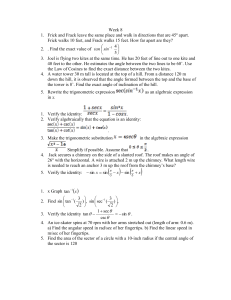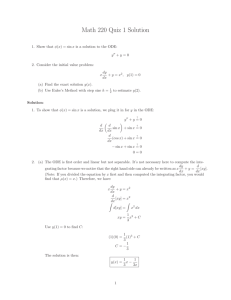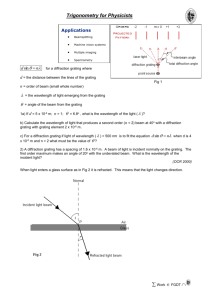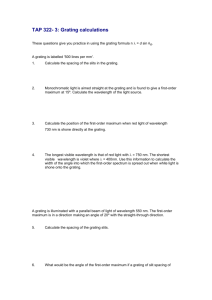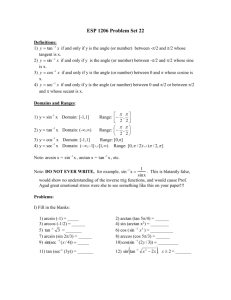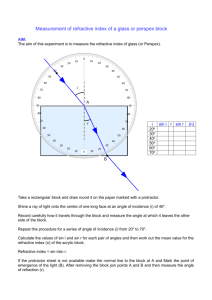Φ21 Fall 2006 HW26 Solutions
advertisement
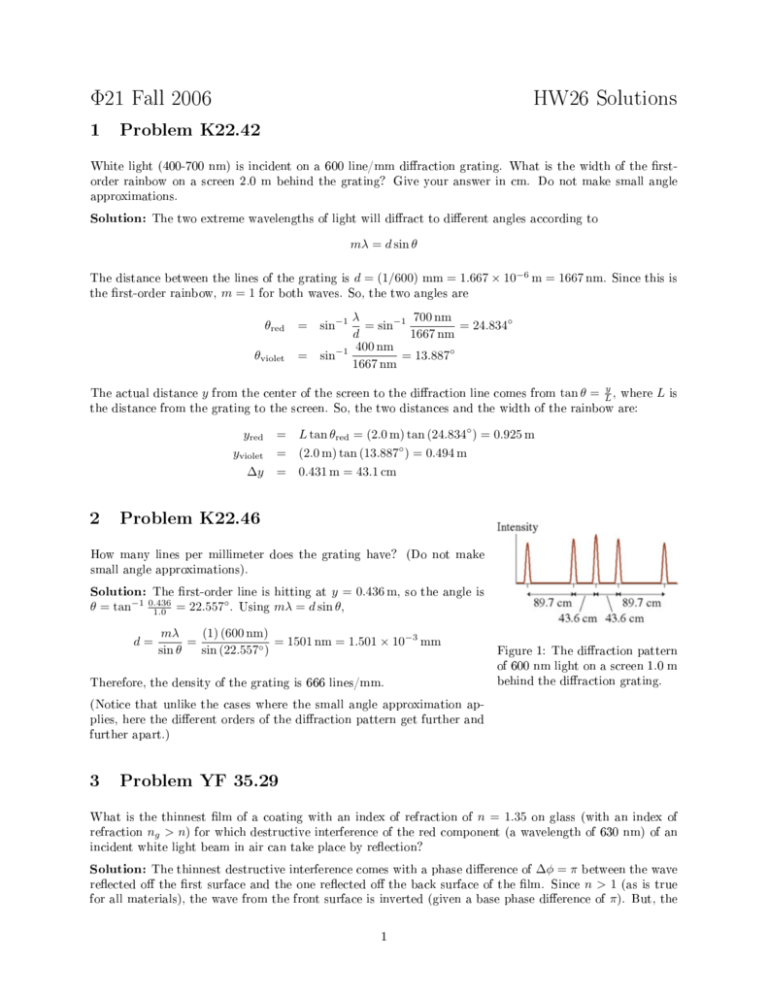
Φ21 Fall 2006 1 HW26 Solutions Problem K22.42 White light (400-700 nm) is incident on a 600 line/mm diraction grating. What is the width of the rstorder rainbow on a screen 2.0 m behind the grating? Give your answer in cm. Do not make small angle approximations. Solution: The two extreme wavelengths of light will diract to dierent angles according to mλ = d sin θ The distance between the lines of the grating is d = (1/600) mm = 1.667 × 10−6 m = 1667 nm. Since this is the rst-order rainbow, m = 1 for both waves. So, the two angles are θred = sin−1 θviolet = sin−1 λ 700 nm = sin−1 = 24.834◦ d 1667 nm 400 nm = 13.887◦ 1667 nm The actual distance y from the center of the screen to the diraction line comes from tan θ = Ly , where L is the distance from the grating to the screen. So, the two distances and the width of the rainbow are: yred yviolet ∆y 2 = L tan θred = (2.0 m) tan (24.834◦ ) = 0.925 m = (2.0 m) tan (13.887◦ ) = 0.494 m = 0.431 m = 43.1 cm Problem K22.46 How many lines per millimeter does the grating have? (Do not make small angle approximations). Solution: θ = tan−1 The rst-order line is hitting at y = 0.436 m, so the angle is = 22.557◦ . Using mλ = d sin θ, 0.436 1.0 d= mλ (1) (600 nm) = = 1501 nm = 1.501 × 10−3 mm sin θ sin (22.557◦ ) Therefore, the density of the grating is 666 lines/mm. Figure 1: The diraction pattern of 600 nm light on a screen 1.0 m behind the diraction grating. (Notice that unlike the cases where the small angle approximation applies, here the dierent orders of the diraction pattern get further and further apart.) 3 Problem YF 35.29 What is the thinnest lm of a coating with an index of refraction of n = 1.35 on glass (with an index of refraction ng > n) for which destructive interference of the red component (a wavelength of 630 nm) of an incident white light beam in air can take place by reection? Solution: The thinnest destructive interference comes with a phase dierence of ∆φ = π between the wave reected o the rst surface and the one reected o the back surface of the lm. Since n > 1 (as is true for all materials), the wave from the front surface is inverted (given a base phase dierence of π ). But, the 1 wave reected from the back surface is also inverted because n < ng , so in the end, both waves start out in phase. The only dierence is the pathlength dierence. The wave from the back surface has to traverse the lm twice, travelling a distance of ∆` = 2y , where y is the thickness of the lm. The wavelength in the lm is λn = λ/n = 630 nm/1.35 = 466.7 nm (remember that the frequency is constant for a given wave). Take ∆`/λn (the fraction of a cycle dierence between the two waves) and multiply it by 2π to get ∆φ, which should be equal to π ( ∆φ = 2π y 4 ∆` λn ) = 2π 2y =π λ/n λ = 116.7 nm 4n = Problem YF 36.29 Visible light passes through a diraction grating that has 900 slits/cm and the interference pattern is observed on a screen that is 2.36 m from the grating. In the rst-order spectrum, maxima for two dierent wavelengths are separated on the screen by 3.20 mm. What is the dierence in these wavelengths (in meters)? (Here you need to make small angle approximations.) Solution: that We'll make the small angle approximation that sin θ ≈ tan θ ≈ θ (with θ in radians). That means y = tan θ ≈ θ L ∆θ ≈ and ∆y 0.0032 m = = 0.00136 rad L 2.36 m The grating spacing is d = (90000 lines/m)−1 = 1.11 × 10−5 m. In the diraction formula, the small-angle approx. with m = 1 gives: mλ = d sin θ ≈ dθ 5 → ∆λ ≈ d∆θ = 15.1 nm Problem K36.33 Plane monochromatic waves with wavelength 540 nm are incident normally on a plane transmission grating having 350 slits/mm. Part A. Find the angle of deviation in the rst order. The slit separation is d = (350000 slits/m)−1 = 2.857×10−6 = 2857 nm. First order means m = 1 in the formula mλ = d sin θ. Solution: θ1 = sin−1 Part B. mλ d Find the angle of the second order. θ2 = sin−1 Part C. ( ( Find the angle of the third order. θ3 = sin−1 ( ) = sin−1 Solution: mλ d ) ( 540 2857 ) = 10.89◦ Second order means m = 2, so = sin−1 ( 2 · 540 2857 ) = 22.21◦ Solution: mλ d ) = sin−1 2 ( 3 · 540 2857 ) = 34.54◦

